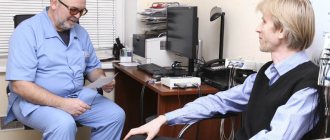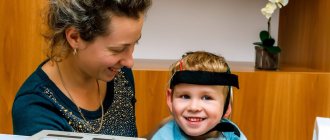Basic information
The biofeedback method (BFB) is primarily a universal principle of human interaction with various systems of his body. Some household appliances, for example, an iron, work according to the same scheme. There the feedback is used as a temperature regulator. The human body uses the same system to regulate mental and physiological processes.
The essence of biofeedback therapy (biofeedback method) is to build an additional data channel that reflects the autonomic functions of the body and allows you to control them. It became possible to carry out such manipulations quite recently, only after the creation of a certain kind of electronic devices that could reflect minimal changes in physiological characteristics simultaneously with the experiment.
Let's find out the principle of the method
The principle of the method is to “return” to the patient on the computer monitor screen or in audio form the current values of his physiological indicators, such as EEG parameters, skin conductivity, cardiogram, heart rate, respiration, electromyogram, temperature, etc. The equipment makes it accessible to patient information that is not perceived by him under normal conditions. Schematically, the biofeedback procedure consists of continuous monitoring of certain electrophysiological indicators and “reinforcement” using multimedia, gaming and other techniques of a given range of values. In other words, the biofeedback interface represents for a person a kind of “physiological mirror” in which his internal processes are reflected. Thus, during the course of biofeedback sessions it is possible to strengthen or weaken this physiological indicator, and therefore optimize the function that this indicator reflects. A necessary component and condition for biofeedback training is the patient’s motivation to achieve results. The process of biofeedback using feedback transforms the patient from an object of medical intervention into an interested object of the recovery process.
History of creation and development
It was only in the late sixties of the last century that the term biofeedback first appeared in the United States. Biofeedback was actually used back in the thirties on rats. Scientists have discovered that animals change the functioning of their organs if they are rewarded or punished. Experiments have shown that using this technique, it is possible to teach a subject to produce a certain amount of gastric juice or maintain a certain level of blood pressure. The impact can also be exerted on the heart and other internal organs. After some time, it was decided to test the biofeedback method on people. This made it possible to understand that a person is able to record the indicators of his body simply by learning about a deviation; he does not need rewards and punishments for this.
The very first documentary publications appeared in the forties and they related to the ability to control cardiac activity. A little later, works became available on the use of myograms as a parameter for teaching people to relax. This made it possible to treat pain of neuromuscular origin. It was only at the end of the last century that the benefits of biofeedback as a psychotherapeutic method were noticed. At the moment, research is still being conducted on this type of effect on the human body. However, this type of therapy has been very successfully used in various areas of medical therapy, allowing to minimize or eliminate drug treatment for patients.
The greatest contribution to its development was made by:
- studies by Miller NE, DiCara LV on the development of visceral conditioned reflexes of the operant type in animals;
- studies by Sterman MB on an increase in the thresholds of convulsive readiness after a conditioned reflex increase in the sensorimotor rhythm in the central gyrus of the cerebral cortex of both animals and humans;
- Kamiya J.'s discovery of the ability of subjects to voluntarily change the parameters of their electroencephalogram in the presence of feedback about their current values.
In the 60s, theoretical research in the field of biofeedback was launched in Western countries (primarily in the USA). Then the crisis of modern medicine, based on drug therapy and surgery, began to be felt. Any operation violated the integrity of the body, and the medicine could have harmful side effects. This situation did not suit either patients or doctors who were looking for new, gentle approaches to treatment.
In the 70s, considerable attention was paid to the study of so-called alpha learning and alpha states caused by an enhanced alpha rhythm in the human EEG.
In the late 1980s and early 1990s, Peniston and Kulkosky conducted their experiments to study the possibility of treating patients with alcoholism using biofeedback technology. They also created a session protocol, which has now become classic: first, temperature training (pretherapy) is carried out, and then alpha-theta training using EEG.
Now, in the era of computerization, the biofeedback method is experiencing rapid development in European countries, the USA and Canada, Israel, and Japan. In particular, currently in the USA the biofeedback method is part of the compulsory health insurance system (the so-called first-line therapy).
Characteristics of psychotherapy
The biofeedback method in psychology is applicable as a relaxation and behavioral component. The basis of this principle was the dependence between the mental and vegetative functions of the human body. Feedback is provided using a sensor. This is a device capable of recording and converting all data relating to any changes in physiological parameters.
This refers to muscle tension, temperature, skin resistance, contraction of the heart muscle, blood pressure, etc. All these indicators are actually related to the emotional state of the patient and his task is to change them in the right direction. This allows a person to learn to self-regulate his body in a targeted manner, with the aim of further influencing the pathological processes occurring in it.
How the session is conducted
During biofeedback therapy, special devices or complexes are connected to a person’s head. The therapy itself takes place in the form of special training. When a person exercises, devices record his physiological state. But they are not shown in the usual form, like, for example, cardiograms, but in the form of auditory and visual signals.
A person perceives these signals, thanks to which he can understand how his brain and the body as a whole currently work. Thanks to such data transfer, a person, using certain techniques, can regulate the functioning of the body, which helps in the development of self-regulation and self-control. Therapy sessions are individual and conducted under the supervision of an instructor.
Types of biofeedback
At the moment, there are two main types of communication: direct and indirect. By direct biofeedback we mean a process carried out on that body function that is not working correctly and this is where the pathology itself is expressed. That is, if a person has hypertension, the effect affects only the level of blood pressure.
And indirect biofeedback is called one that affects all indicators, even if they do not directly relate to a person’s disease. Most often, biofeedback treatment uses temperature and electrical resistance of the skin. The fact is that it is these characteristics that best reflect the psycho-emotional state of a person. With increased tension, these indicators are low, and with relaxation of the body, on the contrary, they increase.
Biofeedback devices
For modern computer systems, it is absolutely no problem to use any indicator of the functioning of the human body, including an encephalogram and an electrocardiogram. There are different devices: some record only one indicator, while others take into account several at once. According to some researchers, the most effective system is one that can reflect several characteristics at once. For this purpose, software and hardware systems were specially developed that operate on a PC.
Software
Specialized software has also been developed aimed at teaching self-regulation during interesting games. Basically, such equipment is used as a separate biofeedback facility for children. The biofeedback method, of course, is effective at the level of its hardware use, but the doctor also influences the therapy. In other words, the psychotherapist can be called the main link between the method itself and training. The subsequent results of the patient’s treatment depend on the doctor’s level of professionalism. The computer in this process is only a means of building a therapeutic relationship that helps the patient learn new things and change their behavior.
Biofeedback trainings are aimed at:
- reducing emotional tension and acquiring relaxation skills;
- reducing negative emotional background;
- reducing anxiety levels;
- suppression of excessive autonomic activity in response to external stimuli and normalization of the functional state of the nervous system (central, peripheral, autonomic);
- increasing the level of self-control and self-organization;
- increasing stress resistance;
- improvement of cognitive functions (memory, attention, thinking);
- teaching new behavioral strategies and consolidating them;
- increasing creative potential.
The role of the doctor in biofeedback therapy
The doctor must immediately prepare the patient for this type of treatment. He gives motivational talks and instills hope that everything will work out. The doctor also explains the essence of the method, by what mechanism it works, and provides basic information about the pathological process that occurs in the patient’s body. It is also the doctor’s task to explain why this technique should help the patient.
When training begins, the psychotherapist must analyze the information provided by the equipment and information received from the patient himself. Based on these data, he explains to the patient how best to use them. The doctor is also obliged to give advice regarding the person's behavior, and suggest experimentation in order to find the best method of controlling the body's functions in a particular case. It doesn’t matter whether there are positive results of the experiments or not, he motivates the patient by talking about their presence.
Types of professional stress
- information stress associated with high mental load.
- communicative stress that arises due to difficulties in communicating with other people, the inability to find an approach to them and resist other people's influence.
- emotional stress associated with the inability to adapt to working conditions, dissatisfaction with the results of professional activities and also arising as a result of conflict situations.
The inability to regulate your mental state and your actions, as well as the inability to manage your behavior, leads to negative and often severe consequences both for yourself and for the people around you. It is important to understand that in order not to experience all the painful consequences of stress, you need to control certain stresses on your body and alternate them with elements of relaxation.
Emotional stress that has reached the level of affect in one form or another has a particularly strong disorganizing effect on a person. The power of affect is such that they can inhibit any other mental processes! With a further increase in the intensity of mental stress, under the influence of emerging negative psychological phenomena, errors begin to appear even in well-practiced skills, and their number gradually increases, and they themselves become more crude. Productivity decreases very quickly. When extreme tension occurs, gross errors appear (for example, a bus driver presses the gas pedal instead of the brake pedal, and then, if he remains alive, cannot explain why he did this). All official instructions and recommendations “fly out of your head,” manifestations of outright cowardice, refusal to carry out risky assignments, deception, dishonesty, and lack of will arise.
Optimization of an employee’s mental states and behavior in extreme situations should include constant monitoring of his condition and, accordingly, psycho-emotional preparation. Otherwise, there is no hope that a stressed employee will act rationally, energetically, quickly and persistently.
Self-control and self-regulation skills.
This is a very important trait that helps you manage yourself, your own behavior, and maintain the ability to perform activities in the most unfavorable conditions. A person with developed self-control knows how to not give in to panic under any, even the most extreme circumstances, maintain clarity of mind, and subordinate his emotions to common sense!
This is precisely what the methodology of biofeedback training in stress management is based on, which allows you to increase efficiency indicators in any activity that requires long-term efforts, as well as great responsibility.
Benefits of biofeedback
When a patient manages to master the skills of managing his body within the office, he needs to transfer them to everyday life. Here the psychotherapist needs to develop in the patient an active attitude towards therapy, increase his responsibility for the health and importance of the person himself. Among the advantages of the biofeedback method, the following are worth highlighting:
- the person personally takes an active part in therapy;
- the method is safe and harmless to health;
- There are practically no side effects (only in very rare cases).
Foot paresis: biofeedback for recovery
With paresis, patients' motor skills are impaired. A medical treadmill with biofeedback, the price of classes for which is calculated by specialists at the Yusupov Hospital for each patient individually, allows you to restore walking skills.
Movement therapy offered by specialists at the Yusupov Hospital Rehabilitation Center is safe. In addition, the biofeedback method is also used in recovery after plaster cast. The devices used for this procedure are distinguished by their functionality and high accuracy of results.
Mechanisms of action
It was noticed that when practicing using biofeedback, a person begins to develop biochemical and physiological reactions that are opposite to stress reflection:
- the a-rhythm of the brain becomes stronger;
- blood pressure decreases;
- heartbeats become less frequent;
- peripheral vascular resistance decreases;
- the body needs less oxygen;
- electrical activity of muscles becomes lower;
- the level of renin, cholesterol, catecholamines and cortisol decreases;
- the endogenous opioid system works in a more enhanced mode;
- vascular reactivity decreases.
In other words, this method helps a person improve their ability to resist stress. Since the patient himself actively participates in therapy, his personal reserves for combating pathology are opened. During the treatment process, a person begins to understand the mechanism of the body and how to make the pathological process positive for him. If a person succeeds in self-regulation, his well-being becomes better, self-esteem and adaptation skills increase. Positive emotions received from observing positive results motivate a person to fight the problem more intensely, which increases the chance of recovery. The result of such treatment is a decrease in fixation on the patient’s experiences, which in turn affects the decrease in hypochondriasis and the level of aggression. The patient gains confidence in himself, his strengths and begins to look at life more positively.
When is the technique particularly effective?
Biofeedback therapy is an effective way to help with insufficient regulatory functioning of the brain.
Neurotherapy is used to regulate in case of disorders of the following body systems:
- Disorders affecting breathing:
- attention deficit hyperactivity disorder;
- problems in the functioning of the respiratory system;
- speech problems;
- vegetative-vascular dystonia;
- allergies.
- Malfunctions of the autonomic nervous system:
- diseases of the cardiovascular system;
- anxiety and other nervous system disorders.
- Improves muscle activity parameters:
- recovery period after injuries;
- problems with the musculoskeletal system (scoliosis, flat feet, poor posture);
- consequences of stroke, paralysis, cerebral palsy;
- severe and persistent headaches.
- Disturbances in the functioning of the brain and central nervous system:
- neurotic disorders;
- rehabilitation after traumatic brain injuries and their consequences.
Efficiency of the technique
At the moment, it has been proven that the biofeedback method after a stroke, for sleep disorders, migraines and other diseases is very effective. Particular importance should be given to the treatment of psychosomatic diseases: biofeedback copes with this task much better than other types of therapy.
A person’s ability to look at the world differently and change their thinking has a great influence on the effectiveness of practice. If you choose the right management program, you can get rid of depressive and obsessive states, hyperactive reactions, and block fears and tension. Thanks to this technique, patients with anxiety conditions can increase their self-control, which allows them to better adapt to the outside world.
Advantages of the BOS-IP device
At the moment, a personal device that performs relaxation therapy is very common. It allows you to create a connection based on the electrical resistance of the skin. This is one of the most modern devices for applying the biofeedback method. Among the main advantages of this device, the following are worth highlighting.
- High sensitivity of the equipment. In other words, a person sees the most minor changes in the state of skin resistance. This characteristic directly reflects the psycho-emotional state of the patient.
- It is easily attached to the hand, and it can be used not only by right-handed people, but also by left-handed people.
- Built-in advanced acoustic indication method with continuous sound and heart rate simulation. At the same time, you can visualize and voice the results of changes in a person’s psycho-emotional state. This greatly simplifies the work of a psychotherapist.
Methodology for using BOS-IP
The doctor can work with the patient individually or gather a group of up to eight people. The patient must sit or lie down during the session. Practice has shown that exercises in a sitting position are better remembered and the acquired skills are then much easier to transfer into everyday life. Before the start of the session, the psychotherapist conducts conversations, first explanatory, and then simply learns about the condition and well-being of the patients. Training lasts no more than half an hour. Conversations take approximately 15-20 minutes. Trainings should be conducted 2 to 5 times a week. The general course usually ranges from 10 to 15 lessons.
How does the biofeedback therapy process work?
The therapy method consists of three stages. It is necessary to have high-quality equipment and an experienced specialist.
- Diagnostics.
- Appointment, determination of the required number of sessions, their composition.
- Direct treatment.
Water with turmeric in the morning on an empty stomach: benefits and possible harm
First of all, an examination is carried out. The client undergoes an EEG procedure - electroencephalogram. The specialist conducts a full assessment of breathing rhythms, heartbeat, brain signals, and establishes the purpose of treatment. Based on the collected data, a specific course of exposure is selected. Today there are relaxing, modeling or activating courses; they can be combined.
It is important to correctly determine the required number and duration of sessions. Usually one visit takes no more than half an hour; in total, about thirty are required. For individual cases, this number may vary. The electrodes of the device are applied to certain areas of the body depending on the disease.










